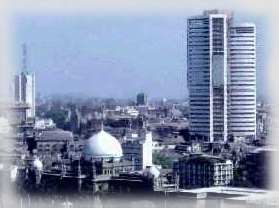 |
Bombay, the capital of the western Indian state of
Maharashtra and the largest metropolis in India, has developed into an industrial complex
second only to Calcutta. Of all the Indian metropolises, it is the most cosmopolitan and
has the greatest concentration of skyscrapers. Greater Bombay, comprising the island of
Bombay (formerly Bombay City), Trombay, and part of Salsette, has a population of
9,909,547 (1991); the Bombay metropolitan area, including its suburbs, has a population of
12,571,720 (1991). The city has been designated the Gateway of India because it is India's
major port of Western contact. The port is built around a harbor and handles the country's
largest tonnage of foreign trade. <<-- Pictograph 1 Mumbai Skyline |
Greater Bombay is separated from the Indian mainland by the waters of
Bassein Creek. The Arabian Sea lies to the west and south. The rock formations exposed in
and around Bombay are of volcanic origin and are referred to as Deccan Trap. Alluvium
cover is found in the lowlands.
Contemporary City Greater Bombay, of which the southernmost part is the
island of Bombay, was formed into a metropolitan municipal organization in 1957. About
two-thirds of the population is concentrated on Bombay Island, which has an area of 67 sq
km (26 sq mi). Bombay has one of the highest population densities in the world, in some
areas reaching 580 persons per sq km (1,500 per sq mi). The city attracts a large number
of migrants, particularly from the states of Maharashtra, Gujarat, and Madhya Pradesh. The
principal languages spoken are Marathi, Gujarati, and Hindi. Of all India's large cities,
Bombay offers the greatest religious diversity. More than half its population is Hindu;
the rest is divided among PARSIS, Christians, Jains, Muslims, and others.
The surrounding Black Cotton Soils, India's greatest cotton-growing area, has made Bombay
one of the largest cotton textile centers in the country, and the cotton textiles industry
employs almost one-half of Bombay's factory workers. The rest are primarily employed in
the production of silk, artificial fibers, chemicals, and glassware and in the dyeing,
bleaching, and printing industries. The city is the home of one of the most successful
business families of India, the Tatas. The University of Bombay, founded in 1857, the
Atomic Research Institute, and the Haffkine Institute, a major center of research in
medicine and allied sciences, are some of Bombay's seats of higher education.
History Occupied since prehistoric times, the area of
Greater Bombay was ruled by the kingdom of Aparanta (north Konkan) in the 2nd century and
subsequently passed under the control of successive Indian dynasties. It formed part of
the kingdom of Gujarat from 1348 to 1534, when the area was ceded to the Portuguese. In
1664 the British were granted control of the island of Bombay, and three years later they
established a fort and a township there. Bombay became the headquarters of the East India
Company in India from 1672 to 1858. In the 19th century, the seven islands of Girgaum
(where the fort is located), Oldman's Island, Colaba, Mazagaon, Parel, Mahim, and Worli
were joined and the alluvial lowlands drained, resulting in a single island. Landmarks of
Western influence of the Victorian era include the Gateway of India, the Victoria
Terminus, the Taj Mahal Hotel, the Rajabai Clock Tower, and the High Court.
Ashok K. Dutt